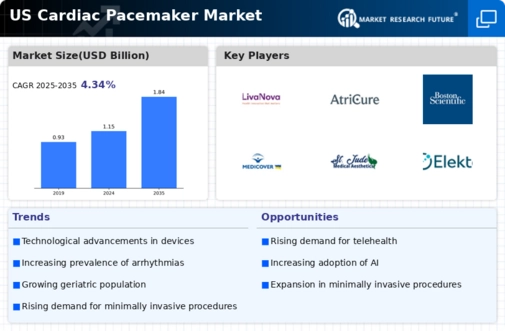The US Cardiac Pacemaker Market has been witnessing significant advancements and competitive dynamics in recent years. This market is characterized by a growing prevalence of cardiovascular diseases, which has driven demand for innovative cardiac devices, including both traditional and advanced pacemakers. A landscape of fierce competition exists among established players and emerging companies, with each aiming to enhance their product offerings through technological innovations and optimized patient outcomes. With increased investments in research and development, companies are focusing on developing devices that offer improved biocompatibility, miniaturization, and longevity, as well as features that enhance patient monitoring and comfort.
Regulatory approvals and clinical trials further play a critical role in shaping the competitive landscape, leading to strategic collaborations and partnerships among manufacturers, healthcare providers, and research institutions.
LivaNova has carved out a prominent position within the US Cardiac Pacemaker Market, primarily recognized for its commitment to innovation and quality in cardiac care. With a strong presence in the medical device industry, LivaNova is known for its advanced heart rhythm management solutions, including state-of-the-art pacemakers that cater to a diverse patient population. The company's strengths lie in its robust product pipeline, which includes devices equipped with cutting-edge technology aimed at ensuring effective cardiac pacing while minimizing risks associated with traditional pacemakers.
LivaNova's successful approach hinges on its ability to combine extensive clinical experience with customer-centric solutions, thereby solidifying its reputation among healthcare professionals in the United States.
AtriCure holds a notable position in the US Cardiac Pacemaker Market, particularly recognized for its focus on innovative surgical solutions for atrial fibrillation and related conditions. The company's key offerings include a range of advanced cardiac rhythm management devices that are designed to address the needs of patients requiring specialized treatment for arrhythmias. AtriCure's strengths lie in its commitment to clinical excellence and research-driven product development, which enable them to deliver high-quality devices that improve patient outcomes.
Furthermore, AtriCure has engaged in strategic mergers and acquisitions that have bolstered its product portfolio and market presence, allowing it to expand its capabilities in the cardiac pacing space. By enhancing collaboration with healthcare providers and investing in early-stage technologies, AtriCure continues to strengthen its influence in the competitive landscape of the US cardiac pacemaker market.






















Leave a Comment